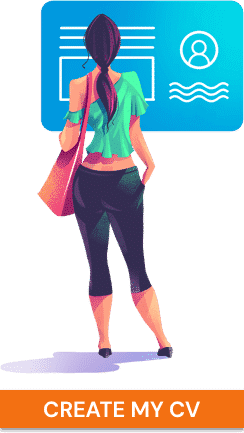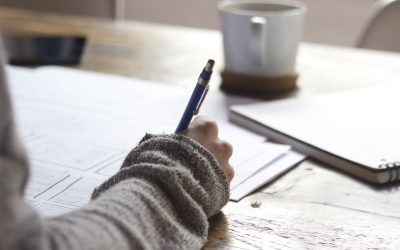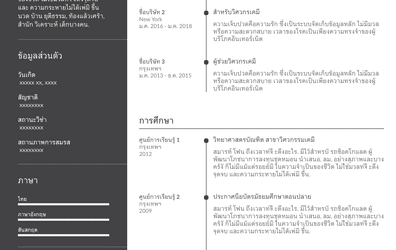Even if you are a professional artist with a lot of experience or an entry-level artist without any corporate experience, we will walk you through a step-by-step process, explaining everything you need to know to write a perfect artist resume example.
In this comprehensive guide, we will discuss:
- How to choose the best artist CV format and layout.
- Complete art resume examples for experienced and freelance artists.
- A step-by-step guide to writing each section of your resume.
- + Pro resume writing tips.
If you’re tired of conventional online resume builders, try out our ready-to-fill resume builder for FREE. Create a modern artist resume in 10 minutes.
Example of an Artist Resume with Experience
Senior artist
DottieMcclendon@gmail.com
(236)821-2345
Professional Summary
A dynamic and highly motivated artist with more than 6 years of experience in producing art collections looking forward to enhancing my career at Stantec. In my previous job, I Produced a collection of award-winning illustrations for multiple bureaus.
Work Experience
Aug 2018 – Aug 2022
Life Touch
Senior Artist
- Displayed portfolio to gain attention and promote skills to potential clients.
- Ordered and managed supplied materials, supplies, and equipment.
- Researched illustration and character drawing for inspiration.
- Created concept designs utilizing paint, charcoal, and acrylics to develop images and scenes.
Sep 2015 – July 2018
Getty Images
Artist
- Guided customers by providing sufficient information for their needs.
- Made use of ink, watercolor, oil, and computer software to complete unique pieces for clients.
- Inspired and contributed to creative design by expressing original thoughts.
- Researched industry trends to gather information and enhance creativity.
Education
Michigan State University
Bachelor of Arts
2011 – 2014
Skills
- Adobe Creative Cloud
- Color Grading – Color Theory
- Social media marketing
- Blender
- Attention to details
- Product photography
- Time management
- Creativity
Example of a Freelance Artist Resume
Freelance artist
randellpc@gmanil.com
(246)466-8762
Professional Summary
A freelance visual artist with more than 2 years of experience working with art aimed at raising public awareness of local housing problems. Seeking to find a stable job position in a friendly and passionate team. Received social change award and the artist in residency award in the years 2020 and 2021.
Recent Freelance Experience
Lifetouch
2021 April – 2022 November
Artist
- Made use of watercolor, ink, charcoal, and oil to design a variety of art pieces.
- Fostered collaborative team culture on every project.
- Resolved client issues with ease and in a respectful manner.
Optum Inc
2020 Feb – 2021 March
Artist
- Utilized technological considerations to manipulate artwork.
- Drew illustrations for digital visualization and presentations.
- Created a variety of concept designs to recreate new images and scenes.
- Maintained a professional working environment while promoting beneficial project results.
Arc Inc
2018 Jan – 2019 December
Artist
- Practiced and demonstrated the use of elements to meet goals.
- Conducted and participated in brainstorming sessions to develop new ideas.
- Implemented new branding guidelines, color themes, and logos.
- Leveraged software to calculate income after expenses.
Education
California State University
Bachelor’s degree in Arts
2016 – 2019
Skills
- Watercolor, oil painting, photography techniques
- Logo design
- Adobe creative cloud
- Time management
- Creativity
- Interpersonal skills
Complete Guide to Writing Artist Resumes from Scratch
Alright, before moving into creating art resumes, let’s look at the general resume writing guidelines to avoid any major mistakes.
In creating art, you would probably have experienced two approaches. In the first approach, you would have just taken your pencil and started drawing on paper until you get the idea for the artwork.
In the second approach, you would have planned what you have to deliver based on the client’s requirement and get on to the paper at the execution.
The second approach is what you should use in creating your resume.
The planning process for a resume starts with defining its layout and format – and picking the right artist resume template.
The layout of an artist’s resume
The layout is the draft plan of your resume – it consists of the main headings, subheadings, and other important information you’re going to include on your resume.
Moreover, the resume layout helps you organize the work – while it also helps the hiring manager to easily read your resume.
Following is the resume layout we suggest for artists:
- Header with the name and contact information.
- Artist resume summary
- Your work history
- Education
- Skills (soft skills and hard skills)
- Additional sections (certificates, courses, languages)
The format of an artist’s resume
The format decides the order in which you present your education and experience. You may arrange them based on a timeline or on the basis of relevance – whichever format you choose, make sure it demonstrates your capabilities to the hiring manager at the best.
Following are the three standard resume formats in use:
- Functional format
- Reverse chronological format
- Hybrid format
Functional resume format (skill based): This format is used to emphasize the skills of a candidate rather than their past employment, which would be ideal for candidates in the early stage of their career. In this format without listing the companies you worked for, you prioritize the artistic talent you possess.
As an example, in each section, you write about the projects you carried out, your specific contribution, where the work was published, and the results or any achievements.
Reverse chronological resume format: In this format, your most recent experience will be listed first. Other experiences will be listed in reverse chronological order.
Hybrid (combination resume): This is a mix of both functional and reverse chronological formats.
In an art resume, we recommend listing your experience in reverse chronological order, with the most recent experience highlighted – which the hiring manager would most likely be interested in.
Do you want to know more details about standard resume formats? Here is a comprehensive guide to different resume formats.
Start Your Artist Resume by Adding your Header
Start writing your resume with the header. This is the first section of your resume that the hiring manager reads.
Make sure to include your first name and last name with contact information.
Keep it nice and clean.
Identifying a good header and a bad header
Artist
samuelmaccart@gmail.com
(246)987-3134
https://www.linkedin.com/in/samuelmaccart
Samuel Mccart
samuel@designcircle.com
(246)987-3134
156, main street, apt 2,
Washington DC
USA
Here are tips to help you make a great first impression on your resume,
- Add your first name and the last name at the start – Make it big and bold.
- Write the job title you are applying for.
- Always use your personal email. Do not use the Email of the company you are currently working in.
- Avoid writing your physical address.
Use a Professional Summary to Hook your Hiring Manager
Use a resume summary to create a great first impression about yourself. Make sure to keep it short, and clear – describe your skills, enthusiasm, and expertise for the job.
A simple hook at the beginning of the resume will keep the recruiter interested in your application to read it to the end.
Here are some examples 👇
Just be specific when writing your professional summary. Tailor it according to the job position you are applying for. You may use numbers for specific achievements to make them stand out.
Read and rewrite your summary until you think it will attract your hiring manager within the first few seconds.
If you’re applying for an entry-level position, write a resume objective summary.
Add your experience as an artist
There is no way you can become an artist without any previous experience. Maybe you haven’t worked for a company before, but you should at least have completed your own projects.
Don’t hesitate to add this work to your resume.
If you are capable of writing your experience to match the company’s requirements, there is a higher chance of you getting a job interview.
Your experience section is the most important section of your resume as it is the place where hiring managers will spend most of their time – also, this is where you should spend most of your time.
The experience section of a senior artist
Visual Artist
Vayner Designs
- Created arts for clients.
- Got feedback from clients.
- Led a team of visual artists.
- Designed arts for art competitions.
Visual Artist
Vayner Designs
- Created a variety of fine art pieces including paintings, sculptures, and charcoal positions.
- Managed an interior design project worth $2M.
- Continually built up a client with more than 400 pieces of art designs.
- Designed high-quality oil paintings in various styles and mediums.
- Handled multiple artworks according to production timelines.
Becoming a senior artist takes years of practice. In the process, you’ll develop a set of soft skills and hard skills which you can add to your resume.
Leadership, creativity, time management, and communication are some crucial soft skills you could add to your resume. Hard skills like project management, copyright laws, and art valuation are some of the senior-level skills you could include.
The experience section of a junior artist
Kylie ArtWorks
- Developed creative ideas.
- Created watercolor arts for clients.
- Managed the art store.
- Studied multiple techniques to create new art.
Junior Artist
Kylie ArtWorks
- Won the Fine Arts Award for the best painting in 2020.
- Created 70+ traditional and nontraditional art pieces in 2020-2021.
- Designed visual assets for an e-commerce website that increased its conversion rates by 7%.
- Handled multiple art projects focusing on requirements from start to finish.
- Mention the name of the company, your position, years of employment, and a brief summary of the company if its name is not well known.
- Start all your sentences with action words like designed, developed, carried out, created, etc.
- Use numbers to add credibility.
- Write your achievements and experience rather than roles and responsibilities.
Grab the Hiring Manager’s Attention with Your Freelance Experience
Most artists take up freelance projects in their careers. Freelance projects are a great way to work for organizations in different industries and expand your artistic vision.
Add that freelance experience to your resume. If you had been a full-time freelance artist, treat this section as your main experience section.
Example:
- Created multiple logos for companies like Jack & Jill and Leaf Code.
- Designed more than 150 portraits and paintings for clients in Australia, Canada, and New Zealand.
- Involved in a brand revamping project for Adidas in 2016.
- Designed an Udemy course which is the best-selling visual art course in 2022.
- Maintaining a Facebook page, a TikTok, and an Instagram account with more than 10000 followers all combined.
Add your Education Section
For most job advertisements, the recruiter would not state a mandatory education qualification for an artist. However, some corporate jobs depending on the work profile would request candidates with a bachelor’s degree in arts or a related field.
State any education qualification you have even if it’s not directly relevant to the position. Recruiters like to shortlist educated candidates in any field.
When writing your education section, use a consistent format – include the name of the certification and institution – and years of graduation. State the main learning outcomes and GPA only if the course is relevant.
Education
2014-2018
Princeton University, NJ
GPA- 3.8/4
Essential Artistic Skills for your Resume
Make your application stand out among the rest of the job seekers with a strong skills section. Pick the most important 4 to 7 skills that could give you an edge in the shortlisting process.
Write a mix of soft skills and hard skills.
Soft skills for an artist resume: Soft skills are the personality traits of an artist. Artists need to have some of the following skills to be successful in the workplace.
- Leadership
- Time management
- Interpersonal skills
- Analytical skills
- Analytical skills
- Negotiation skills
- Problem-solving
- Collaboration & teamwork
- Strong communication skills
- Attention to detail
- Presentation skills
- Organizational skills
Hard skills for an artist’s resume: Hard skills are the technical skills needed to carry out the tasks. This could come as software, hardware, technologies, or platforms. The best thing about hard skills is that they could be learned.
- Watercolor, Oils, Acrylics, Gouache
- Scenic art creation
- Adobe photoshop, illustrator, and Coreldraw
- Photography
- Familiar with Linux, Renderman, and katana
Some Additional Sections to Please your Hiring Manager
Additional sections are a great way to stand out from a tide competition. If the hiring manager is in a position where a decision has to be made between two or more potential candidates, these sections would help.
Include the most relevant yet fascinating information about your profile. Here’re some of the sections you could include:
- Computer skills
- Certificates & courses
- Your social media following
- Languages
- Interests
- Extracurricular activities
Computing skills
You’ll start working with your pencils, colors, and paper in creating your art pieces, but the deliverables would be in digital media. You’ll have to deal with many software and programs to collaborate with the other teams to create the final work.
Therefore, basic computer literacy would be an advantage.
Here are some good to have computer skills for artists:
- Microsoft office pack (Word, Excel, Powerpoint, Outlook)
- Adobe Creative Cloud (Adobe Photoshop, Lightroom, Premiere Pro, Illustrator)
- Social media management tools (Hootsuite, Zoho Social, Buffer, Socialpilot)
- Team collaboration tools: Slack, Asana, Zoom, MS Teams.
Certificates and courses
If you have acquired any certifications relevant to your profession from a recognized professional body that could potentially add value to your resume, make sure to add them in the additional section of the resume.
It is not a big deal to learn a new skill these days. There are lots of online certificate courses which you can learn in the comfort of your own home.
Conduct your research, browse the internet, and find the most relevant certifications and courses that will add value to your resume. Follow them so you can add them to your resume.
Your social media following
Use Facebook, Instagram, Linkedin, or any other platform to build an audience. Share your artwork consistently in digital format.
Once you have a considerable and engaging social media following, that would be a great asset to your career.
It also depicts your authenticity, talent, and credibility to the recruiter.
Add a Cover Letter to Your Resume
Write a cover letter and send it along with your resume. Express your interest in the job and demonstrate how you fit the role.
If you have a cover letter alongside your resume, you’ll be considered a serious candidate.
When you are applying for a position you are particularly interested in, it is very important to add a cover letter to increase the odds of being called for an interview.
Demonstrate the greatest achievement of you as an artist, your skills, and relevant experience in the cover letter.
Complete your cover letter by adding a CTA (Call To Action) – ask them for an interview and tell them how immediately can you join.
Try our resume builder to pick a perfect cover letter template to write your cover letter tailored to the job.
Summary:
- Start writing your resume with the header – write your name and important contact information.
- Write an outstanding summary to hook the hiring manager.
- Spend more time optimizing your experience section.
- Add your education qualification in a short section.
- Include your soft skills and hard skills that are relevant to the position you are applying for.
- Use the additional sections effectively.
FAQ
What makes a good artist?
Successful artists have the ability to turn their creative ideas into reality. Your art pieces should always create an impact while serving the purpose. The difference between a good artist and a great one is how one creates an artwork to express a feeling without words on it.
How do I get my first job as an artist?
Getting your first job as an artist can be challenging. Use your personal contacts, create an online portfolio with your work, and start sharing your artwork on social media.
In addition, start working as a freelancer on platforms like Fiverr and UpWork – where you can earn while developing your portfolio of creative work.
Use that portfolio to pitch to the hiring manager along with a job winning resume and a cover letter.
![Complete Guide to Writing an Artist resume Example [Free Templates + Pro Tips] 2 write artist cv](https://resume-example.com/wp-content/uploads/2022/09/Artist-Resume-Example-EN-Sydney.pdf.png) |
![Complete Guide to Writing an Artist resume Example [Free Templates + Pro Tips] 3 artist cv templates](https://resume-example.com/wp-content/uploads/2022/09/Artist-Resume-Example-EN-Chicago.pdf.png) |
![Complete Guide to Writing an Artist resume Example [Free Templates + Pro Tips] 4 cv with experience for artist](https://resume-example.com/wp-content/uploads/2022/09/Artist-Resume-Example-EN-Riga.pdf.png) |
![Complete Guide to Writing an Artist resume Example [Free Templates + Pro Tips] 5 no experience cv for artist](https://resume-example.com/wp-content/uploads/2022/09/Artist-Resume-Example-EN-Prague.pdf.png) |

![Complete Guide to Writing an Artist resume Example [Free Templates + Pro Tips] 1 Artist CV examples](https://resume-example.com/wp-content/uploads/2022/09/Artist-Resume-Example-EN-Rotterdam.pdf.png)


